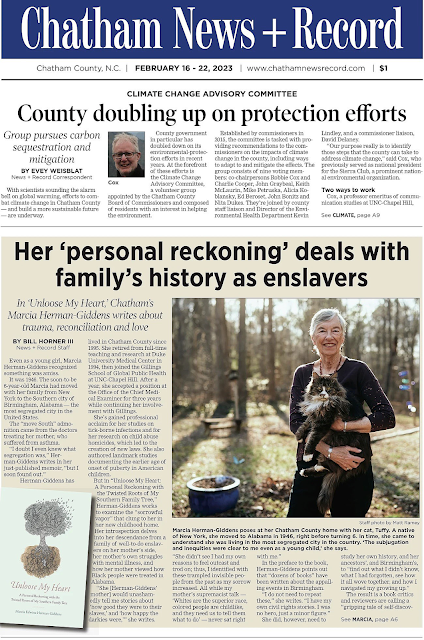 |
Trisha Purdon, of Kansas, left, and Beth Haskovec, of Wisconsin
(Photos via the Rural Assembly)
|
"Everywhere Radio" wants to be, well,
everywhere rural. But you know what is not everywhere but might need to be? State
Offices of Rural Prosperity. The concept has gotten a start in Kansas and Wisconsin, the first states to launch these hive-like hubs. Both ORPs are headed by women: Trisha Purdon in Kansas and Beth Haskovee in Wisconsin, who were interviewed by the
Rural Assembly's "Everywhere Radio" podcast host Whitney Kimball Coe. Below are excerpts and paraphrases from their
dual podcast.
Coe gave a bit of background and asked Purdon and Haskovee to recall their offices' foundations.Kansas was the first state to establish its
Office of Rural Prosperity, in 2018, following a "listening tour" that found citizens concrned about housing, child care, and health care (the top three), broadband, infrastructure, economic development, health care and general community development, including arts and culture and place-making.
In Iowa, "We worked with the
Aspen Institute to create something called the "Rural Voices Report," based on three different listening sessions across the state," Haskovee said. "I feel like the power of rural communities are people getting sitting down at that kitchen table and just talking through solutions to problems that they're facing. And the power of the state to be able to open up that conversation and really be listening and use those comments and the input from communities across the state to shape an agenda, I think, is unique. And that doesn't always happen, that we're that proactive in seeking input in the way that we're shaping the work that gets done."
Both women are relatively new to the jobs; Coe asked them what "a day in the life" was like. The simple answer was "busy bees." Purdon said, "First thing, what's up on the docket at the legislature room? How do I help out our team? There's a lot of communities who are trying to get legislation passed. . . . But we work in a team. We've kind of divvied up our responsibilities. Right now, we're rolling out a ton of grants, so we're just every day checking in on all the grant funds and where those things are and trying to keep our heads above water, helping everyone get through that process."
Haskovee agreed and added: "We're applying regional collaboration. It's so important to our work and working with those regional planning commissions and economic development organizations. So we're applying to a federal opportunity to get some technical assistance to better align our rural plan at the state level with all of the regional community economic development plans and including the Great Lakes and our tribal council in that as well, and understanding how the economic development needs at the regional level and the tribal level align with the state."
Coe asked the two about the "federal dollars that are coming in. . . how are they positioned to help translate those dollars and make sure that they are connecting to rural stakeholders as well?" Haskovee said, "I inherited a
bipartisan infrastructure law task force that was really focused on helping communities understand what was available. Through that legislation, we created a website with all the links to all the state agencies and what resources they had available. . . . Historically, matching dollars has been a problem for rural communities. They just don't have the budgets to go after some of those federal dollars. And so helping them understand that that was taken into consideration in some of these grant programs and the same match requirements that have been typically required have been waived or altered through this legislation to really help rural communities."
Purdon said, "Like Beth had said, we have a lot of volunteers who are doing this [grant applications]. We have a lot of city clerks and county clerks who are doing this. City and county commissioners that have no experience in writing a massive
Department of Agriculture grant. . . . We did a kind of convening for all these folks who are volunteers mostly to do basic trainings on if you're interested in water, we're going to have four or five very intense training sessions on the different water programs that are coming up. . . . And we had experts come into kind of walk them through that."
With the depth and breadth of their responsibilities, Coe asked what keeps them going on hard days. |
| Kiowa is in Barber County (Wikipedia) |
Purdon, who is from Kiowa, Kansas, pop. 900, explained: "I saw us make a difference here in Montgomery County [and Coffeyvile], so now I do it at the state level, and I'm very passionate about it. I go to all these small towns, and I see, like the community of Matfield Green, which I thought was a truck stop on the Interstate, but it's a tiny, tiny town nestled in the Flint Hills. It's the most beautiful place on Earth. It [the population] was down to just a few houses, and now they've grown their population by 30 people in the last few years."
 |
| Waukon is in Allamakee County (Wikipedia) |
Haskovee, who is from Waukon, Iowa, pop. 3,800, said: "I love rural development work so much because it is so much heart. It is so much about relationships and people and how welcoming and open people are once you get to know them and are willing to pull up your sleeves and get work done. I love that. One of my mom's favorite quotes is, 'May you always have enough and plenty for the day. May you never have enough to waste or throw away.'"





















